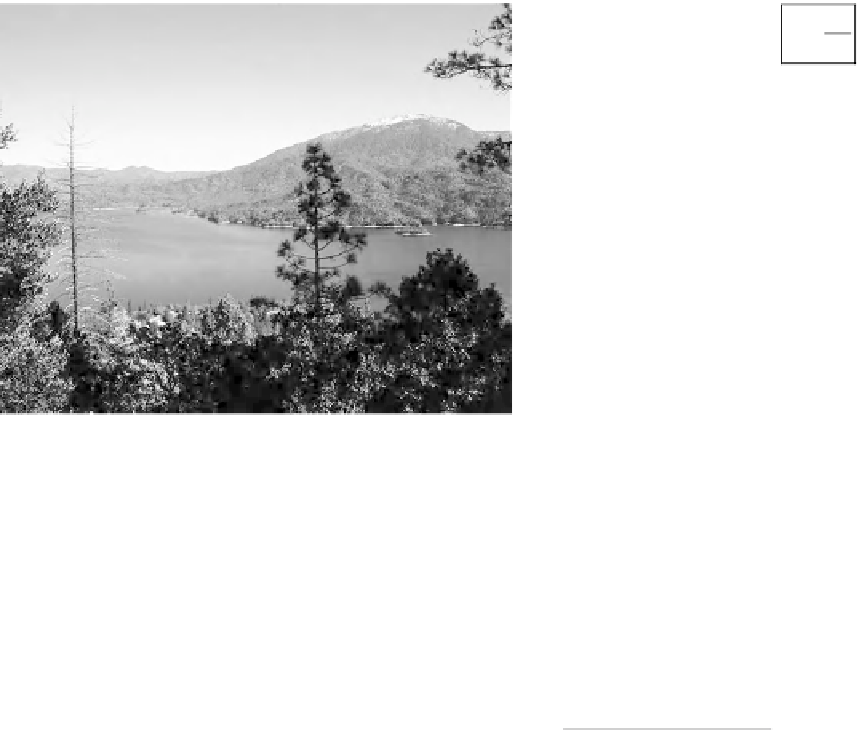Environmental Engineering Reference
In-Depth Information
V
Q
L
t
=
(7.1)
d
o
where
V
L
is the (average) volume of the impoundment
(L
3
) and
Q
o
is the average outflow rate (L
3
T
−1
). The
hydraulic detention time is sometimes called the
reten-
tion time
or
residence time
. Detention times in large
lakes are typically on the order of years, while the
detention times for water in rivers and streams are typ-
ically on the order of days. Detention times in lakes
and reservoirs are typically classified as “short” if they
are less than 1 year and “long” if they are more than 1
year. In lakes or reservoirs with short detention times,
the degree of stratification depends on the detention
time, whereas for long detention times (>1 year), strati-
fication can be fully developed and independent of the
detention time. In cases of “very short” detention times
(<14 days), stratification does not develop (Jørgensen
et al., 2005).
Figure 7.1.
Typical lake view.
Source
: U.S. National Park
Service (2005).
EXAMPLE 7.1
with similar land uses. This is due primarily to the fact
that the drainage basins of reservoirs are generally
larger than those of lakes. In a sample of lakes and res-
ervoirs in the United States, the ratio of drainage basin
area to water body (surface) area for reservoirs was on
average 14 times higher than for lakes.
Designated uses of lakes include water supply, recre-
ation, flood control, power generation, and navigation.
Lake ecosystems support complex and important food
web interactions and provide habitat needed to support
numerous threatened and endangered species. The most
common pollutants affecting lakes, reservoirs, and ponds
are nutrients, metals, and siltation, with major pollutant
sources being agricultural runoff and urban runoff.
Nutrients, primarily nitrogen and phosphorus, contrib-
ute to increased biomass, sometimes to undesirable
levels. Significant nutrient sources include agricultural
runoff, industrial and municipal wastewater discharges,
and atmospheric deposition. Most reports of metal con-
tamination in lakes are a result of the detection of
mercury in fish tissue, and the major source of mercury
contamination in lakes is thought to be atmospheric
transport and deposition from electrical power plants.
Over geologic time, lakes naturally fill with sediment,
which tends to deposit concentrically from the outer
edges (where the velocities are the lowest) toward the
middle.
Water pollution problems in impoundments such as
lakes and reservoirs can be quite persistent because of
the long
hydraulic detention times
in these systems. The
hydraulic detention time,
t
d
(T), is defined by the
relation
The volumes and outflow rates for the Great Lakes are
shown below (after Chapra and Reckhow, 1983). Deter-
mine the detention times for the Great Lakes.
volume
Outflow
Lake
(10
9
m
3
)
(10
9
m
3
/year)
Superior
12,000
67
Michigan
4900
36
Huron
3500
161
Ontario
1634
211
Erie
468
182
Solution
Using Equation (7.1) yields the the following results:
V
L
Q
o
t
d
Lake
(10
9
m
3
)
(10
9
m
3
/year)
(years)
Superior
12,000
67
179
Michigan
4900
36
136
Huron
3500
161
22
Ontario
1634
211
8
Erie
468
182
3
Based on these results, the detention times in the Great
Lakes range from a low of 3 years in Lake Erie to a high
of 179 years in Lake Superior.




















Search WWH ::

Custom Search